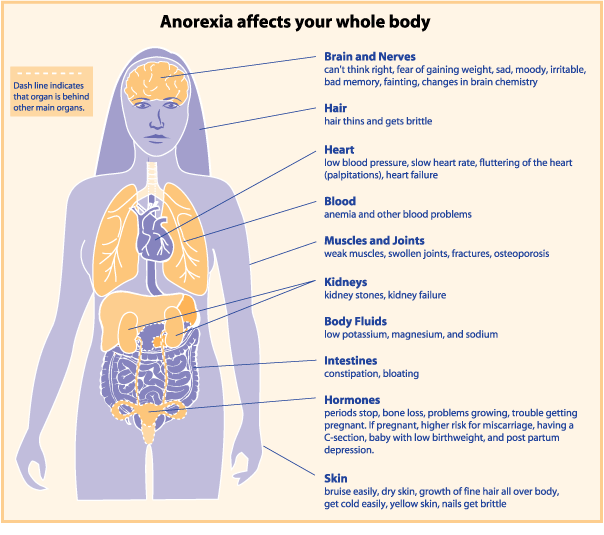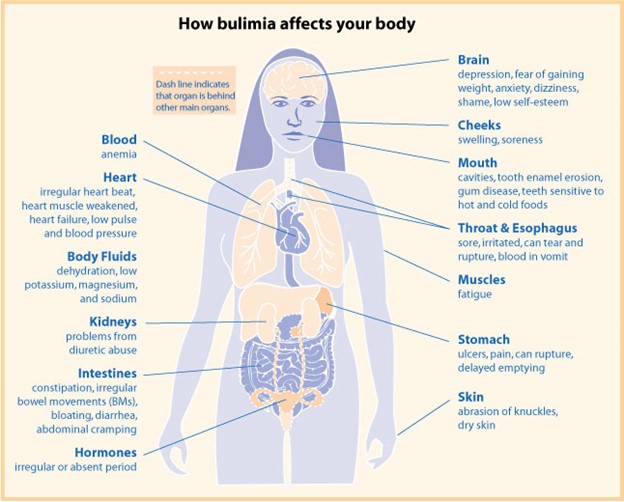Types of Eating Disorders DSM 5
- The three most common eating disorders are anorexia nervosa (AN), bulimia nervosa (BN), and binge eating disorder (BED). There are also other types of eating disorders such as avoidant/restrictive food intake disorder (ARFID), pica, rumination disorder, and unspecified feeding or eating disorder (UFED).
- AN is characterized by a persistent restriction of energy intake leading to significantly low body weight; a distorted perception of body weight or shape; an intense fear of gaining weight or becoming fat; and in females, amenorrhea (absence of menstrual cycles) for at least three consecutive months.
- AN can be divided into two subtypes: restricting type (RT) and binge-eating/purging type (BPT). RT involves excessive dieting, fasting, or exercising to lose weight. BPT involves recurrent episodes of binge eating (eating large amounts of food in a short period of time) followed by inappropriate compensatory behaviors such as self-induced vomiting, laxative abuse, diuretic abuse, or enemas to prevent weight gain.
- BN is characterized by recurrent episodes of binge eating followed by inappropriate compensatory behaviors to prevent weight gain; a sense of lack of control over eating; a distorted perception of body weight or shape; and an excessive influence of body weight or shape on self-evaluation.
- BN differs from AN-BPT in that people with BN usually maintain a normal or slightly above normal body weight; experience more guilt, shame, and remorse after bingeing and purging; and acknowledge their problem.
- BED is characterized by recurrent episodes of binge eating without compensatory behaviors; a sense of lack of control over eating; and marked distress over binge eating. Binge eating episodes are associated with at least three of the following: eating more rapidly than normal; eating until feeling uncomfortably full; eating large amounts of food when not physically hungry; eating alone because of feeling embarrassed by how much one is eating; feeling disgusted with oneself, depressed, or very guilty after overeating.
- BED differs from BN in that people with BED do not engage in compensatory behaviors; have lower levels of body dissatisfaction; and have higher rates of obesity and comorbid medical conditions.
- ARFID is characterized by an apparent lack of interest in eating or food; avoidance based on the sensory characteristics of food; concern about aversive consequences of eating; or a combination thereof. As a result, the person fails to meet appropriate nutritional and/or energy needs leading to one or more of the following: significant weight loss or failure to achieve expected weight gain or growth; significant nutritional deficiency; dependence on enteral feeding or oral nutritional supplements; marked interference with psychosocial functioning.
- ARFID differs from AN in that people with ARFID do not have a distorted perception of body weight or shape; do not have an intense fear of gaining weight or becoming fat; and do not restrict their food intake for weight-related reasons.
- Pica is characterized by persistent eating of nonnutritive, nonfood substances over a period of at least one month. The eating of nonnutritive, nonfood substances is inappropriate for the developmental level of the individual and is not part of a culturally supported or socially normative practice.
- Pica can be associated with various medical conditions such as iron-deficiency anemia, lead poisoning, or pregnancy. It can also be related to psychological factors such as stress, trauma, or developmental disorders.
- Rumination disorder is characterized by repeated regurgitation of food over a period of at least one month. Regurgitated food may be re-chewed, re-swallowed, or spit out. The repeated regurgitation is not attributable to a medical condition such as gastroesophageal reflux disease or pyloric stenosis. The behavior does not occur exclusively during the course of an eating disorder or other mental disorder.
- Rumination disorder can affect people of any age, but it is more common among infants, children, and people with intellectual disabilities. It can cause malnutrition, weight loss, dental erosion, and aspiration pneumonia.
- UFED is a category for feeding or eating disorders that do not meet the full criteria for any of the other disorders. Examples include atypical anorexia nervosa (all criteria for AN are met except that the individual’s weight is within or above the normal range); subthreshold bulimia nervosa (all criteria for BN are met except that the binge eating and inappropriate compensatory behaviors occur less than once a week and/or for less than three months); subthreshold binge eating disorder (all criteria for BED are met except that the binge eating occurs less than once a week and/or for less than three months); purging disorder (recurrent purging behavior to influence weight or shape in the absence of binge eating); night eating syndrome (recurrent episodes of night eating, as manifested by eating after awakening from sleep or by excessive food consumption after the evening meal).
|
Type |
Diagnostic Criteria |
|
Anorexia Nervosa |
- Restriction of energy intake relative to requirements, leading to a significantly low body weight in the context of age, sex, developmental trajectory, and physical health - Intense fear of gaining weight or becoming fat, or persistent behavior that interferes with weight gain, even though at a significantly low weight - Disturbance in the way one’s body weight or shape is experienced, undue influence of body weight or shape on self-evaluation, or persistent lack of recognition of the seriousness of the current low body weight |
|
Bulimia Nervosa |
- Recurrent episodes of binge eating. An episode of binge eating is characterized by both of the following:
- Recurrent inappropriate compensatory behaviors in order to prevent weight gain, such as self-induced vomiting; misuse of laxatives, diuretics, or other medications; fasting; or excessive exercise - The Binge eating and inappropriate compensatory behaviors both occur, on average, at least once a week for 3 months - Self-evaluation is unduly influenced by body shape and weight - The disturbance does not occur exclusively during episodes of anorexia nervosa |
|
Binge Eating Disorder |
- Recurrent episodes of binge eating. An episode of binge eating is characterized by both of the following:
- The binge-eating episodes are associated with three (or more) of the following:
- Marked distress regarding binge eating is present - Binge eating occurs, on average, at least once a week for 3 months - Binge eating is not associated with the recurrent use of inappropriate compensatory behavior as in bulimia nervosa and does not occur exclusively during the course of bulimia nervosa or anorexia nervosa |


Nursing Test Bank
Naxlex Comprehensive Predictor Exams
Questions on Types of Eating Disorders DSM 5
Correct Answer is D
Explanation
Correct Answer is ["A","B","C","D"]
Explanation
Correct Answer is C
Explanation
Correct Answer is A
Explanation
Correct Answer is A
Explanation
Correct Answer is C
Explanation
Correct Answer is B
Explanation
Correct Answer is A
Explanation
Correct Answer is C
Explanation
Correct Answer is C
Explanation
Correct Answer is C
Explanation
Correct Answer is A
Explanation
Correct Answer is C
Explanation
Correct Answer is C
Explanation
Correct Answer is A
Explanation
Correct Answer is A
Explanation
Search Here
Related Topics
- Types of Eating Disorders DSM 5 - Eating and Obsessive-Compulsive Disorders
- Obsessive-compulsive disorders - Eating and Obsessive-Compulsive Disorders
- Clinical Picture of Abuse and Violence - Eating and Obsessive-Compulsive Disorders
- Child and Elder Abuse - Eating and Obsessive-Compulsive Disorders
- Child Abuse - Eating and Obsessive-Compulsive Disorders
- Elder Abuse - Eating and Obsessive-Compulsive Disorders
More on Nursing
Free Nursing Study Materials
Access to all study guides and practice questions for nursing for free.
- Free Nursing Study Trials
- Free Nursing Video tutorials
- Free Nursing Practice Tests
- Free Exam and Study Modes
- Free Nursing Revision Quizlets
